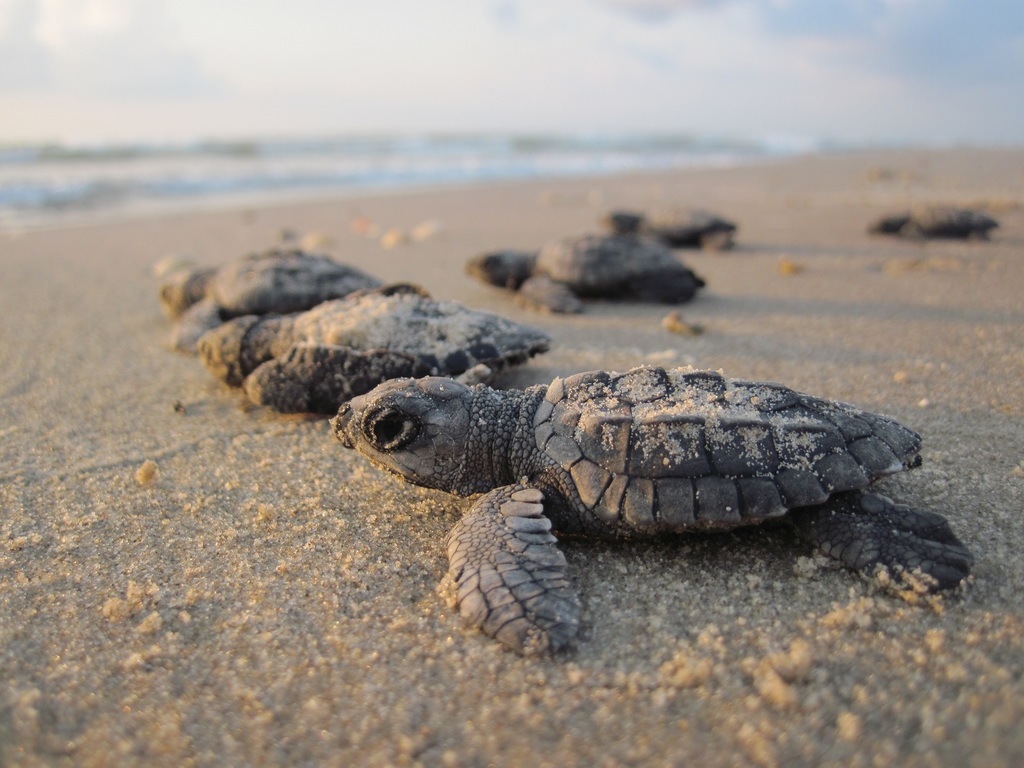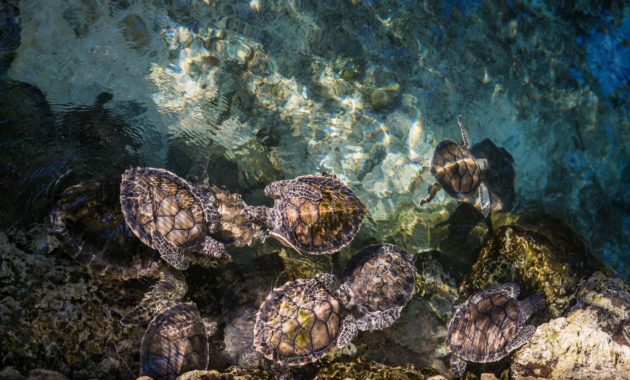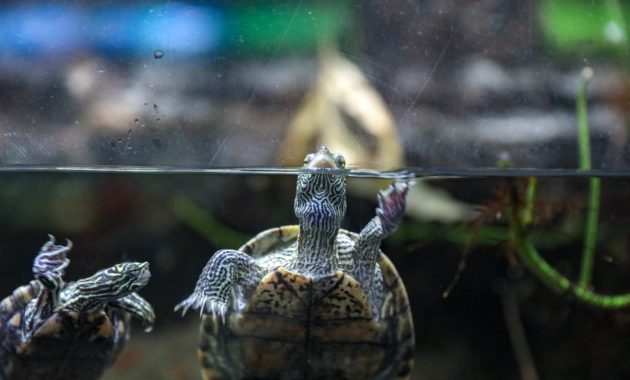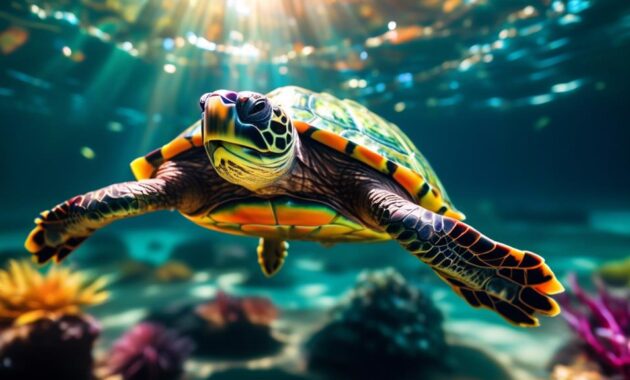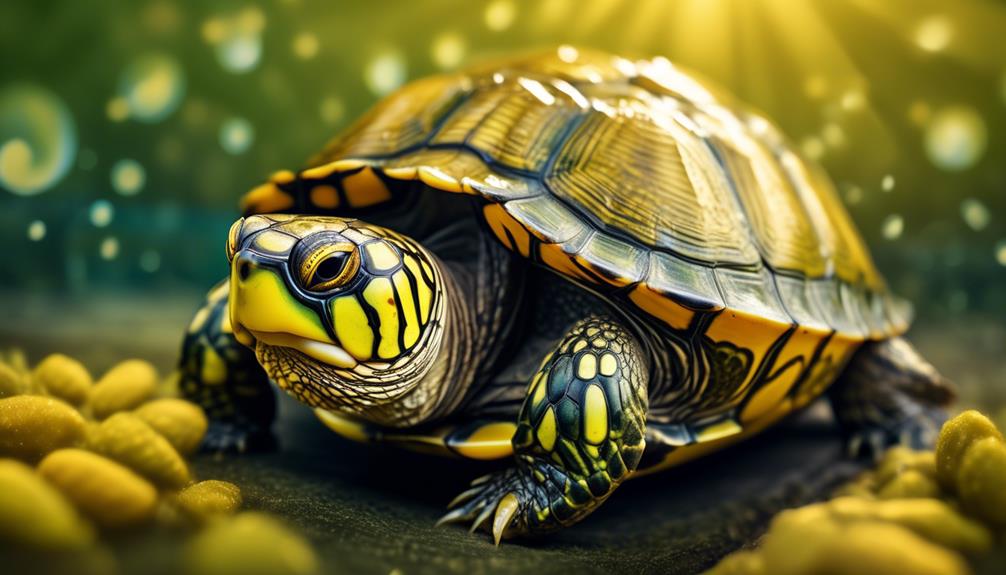
Are you ready to take a plunge into the captivating world of the Yellow-Bellied Slider turtle?
Prepare to be amazed as we uncover the secrets of this intriguing creature and explore its unique characteristics.
From its size and lifespan to its diet and native habitat, the Yellow-Bellied Slider turtle holds a wealth of fascinating information waiting to be discovered.
So, get ready to embark on this educational journey and uncover the wonders that lie beneath the surface.
Key Takeaways
- Yellow-Bellied Slider turtles can reach lengths of 8 to 13 inches for females and 5 to 9 inches for males, with a lifespan of 20+ years.
- They require a tank of at least 75 gallons and a specific habitat with shallow bodies of water, vegetation, and basking areas.
- Their diet consists of a balanced mix of protein, vegetables, and calcium-rich foods, including commercial turtle diets, aquatic plants, worms, fish, insects, and vegetables.
- Yellow-Bellied Sliders are comparable to Red-Eared Sliders and Cumberland Sliders in terms of size, lifespan, dietary requirements, and moderate maintenance care.
Size and Lifespan
Yellow-Bellied Sliders are medium-sized turtles with females reaching lengths of 8 to 13 inches and males growing to 5 to 9 inches. These turtles have a lifespan of 20+ years, making them a long-term commitment.
When it comes to their diet, Yellow-Bellied Sliders can be fed a commercial turtle diet, along with non-toxic aquatic plants, worms, fish, insects, and vegetables.
Taking care of these turtles requires moderate maintenance. As they grow, they need a lot of space. For the first three years, a smaller tank of around 40 gallons will suffice, but eventually, they'll require an aquarium of at least 75 gallons.
It's important to note that Yellow-Bellied Sliders aren't suitable for those seeking a cuddly and overly affectionate pet. They're comparable to Red-Eared Sliders and Cumberland Sliders.
In their native habitat, Yellow-Bellied Sliders are found throughout the southeastern portion of the United States, from Virginia to Alabama. They prefer shallow bodies of water with aquatic vegetation, basking areas, and soft bottoms, such as marshes, lakes, ponds, swamps, rivers, and wetlands.
Diet
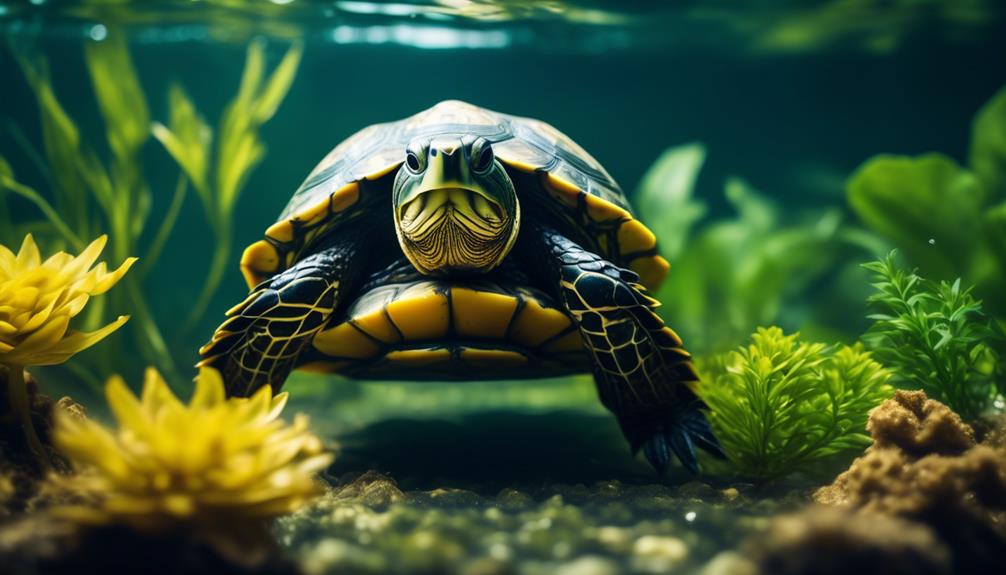
To properly care for a Yellow-Bellied Slider turtle, it's important to understand their dietary needs. Here are four important things to know about their diet:
- Yellow-Bellied Sliders can be fed a commercial turtle diet. This ensures they receive all the necessary nutrients to stay healthy and thrive.
- They also eat non-toxic aquatic plants, worms, fish, insects, and vegetables. Providing a varied diet is essential for their overall well-being.
- It's crucial to offer them a balanced mix of protein, vegetables, and calcium-rich foods. This helps support their growth and shell development.
- Remember to feed them in a separate container to prevent the accumulation of waste in their habitat. Regularly clean their feeding area to maintain hygiene.
Difficulty of Care
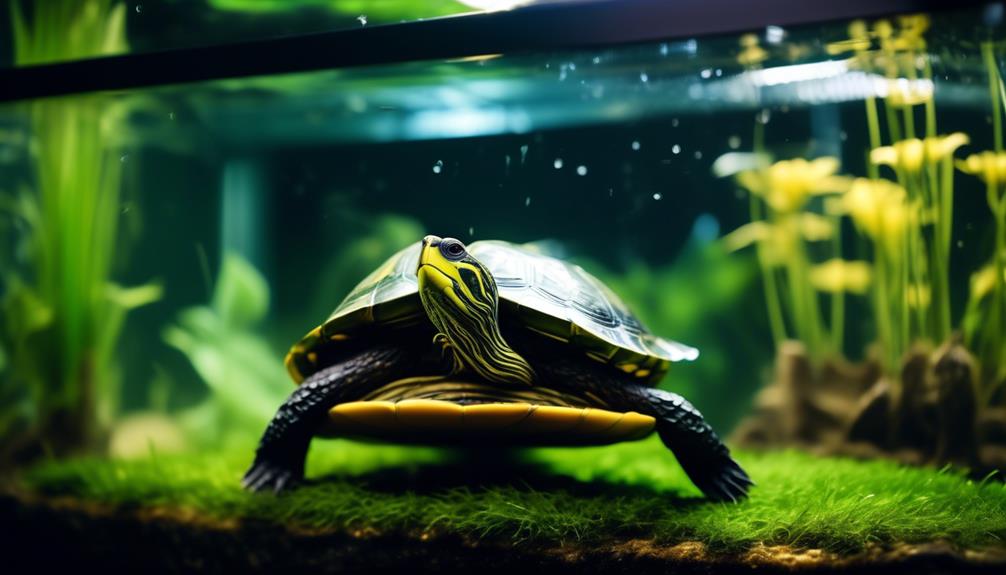
Taking care of a Yellow-Bellied Slider turtle requires moderate maintenance. These turtles need a lot of space as they grow, so for the first three years, you can house them in a smaller tank of around 40 gallons. However, eventually, they'll require an aquarium of at least 75 gallons to accommodate their size.
It's important to note that Yellow-Bellied Sliders aren't suitable for those seeking a cuddly and overly affectionate pet. They require a specific habitat with shallow bodies of water, aquatic vegetation, basking areas, and soft bottoms.
While they may not be the easiest pets to care for, with the right setup and attention to their needs, Yellow-Bellied Sliders can thrive and provide years of enjoyment.
Comparable Breeds
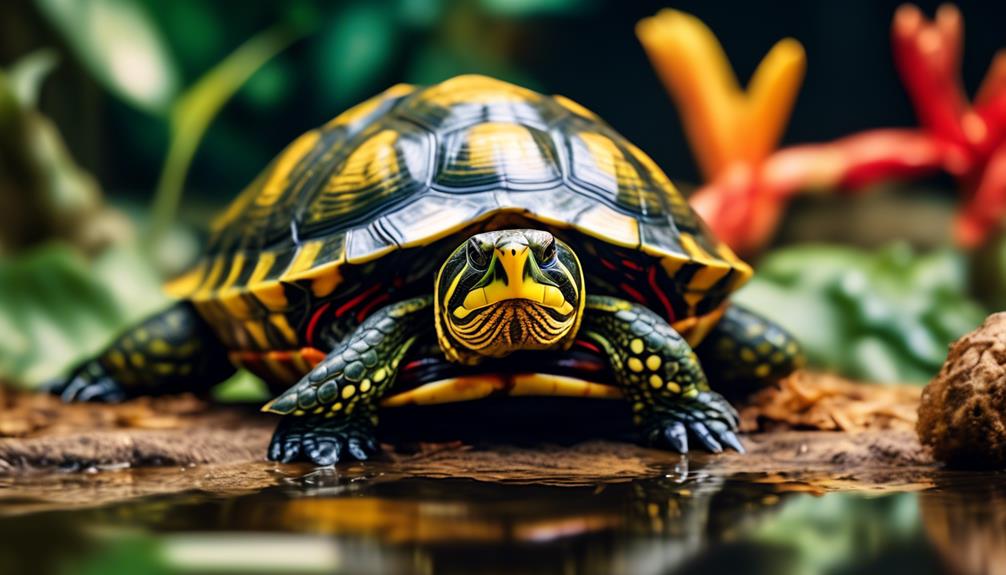
When considering turtle breeds to compare with the Yellow-Bellied Slider, it's important to look at similar species such as the Red-Eared Slider and Cumberland Slider. These breeds share several characteristics with the Yellow-Bellied Slider, making them worthy of comparison. Here are four key points to consider:
- Size and Lifespan:
Like the Yellow-Bellied Slider, both the Red-Eared Slider and the Cumberland Slider are medium-sized turtles. They also have similar lifespans of 20+ years, providing long-term companionship.
- Diet:
All three breeds have similar dietary requirements, including commercial turtle diets, non-toxic aquatic plants, worms, fish, insects, and vegetables. This makes it easier to provide a balanced and nutritious diet for these turtles.
- Difficulty of Care:
Taking care of Red-Eared Sliders, Cumberland Sliders, and Yellow-Bellied Sliders requires moderate maintenance. They all need ample space as they grow, starting with a smaller tank and eventually requiring a larger aquarium.
- Native Habitat:
These turtles are found in similar habitats throughout the southeastern United States, including marshes, lakes, ponds, swamps, rivers, and wetlands. This means that their environmental needs and preferences are comparable.
Considering these similarities, the Red-Eared Slider and Cumberland Slider are excellent breeds to compare with the Yellow-Bellied Slider when choosing a pet turtle.
Native Habitat
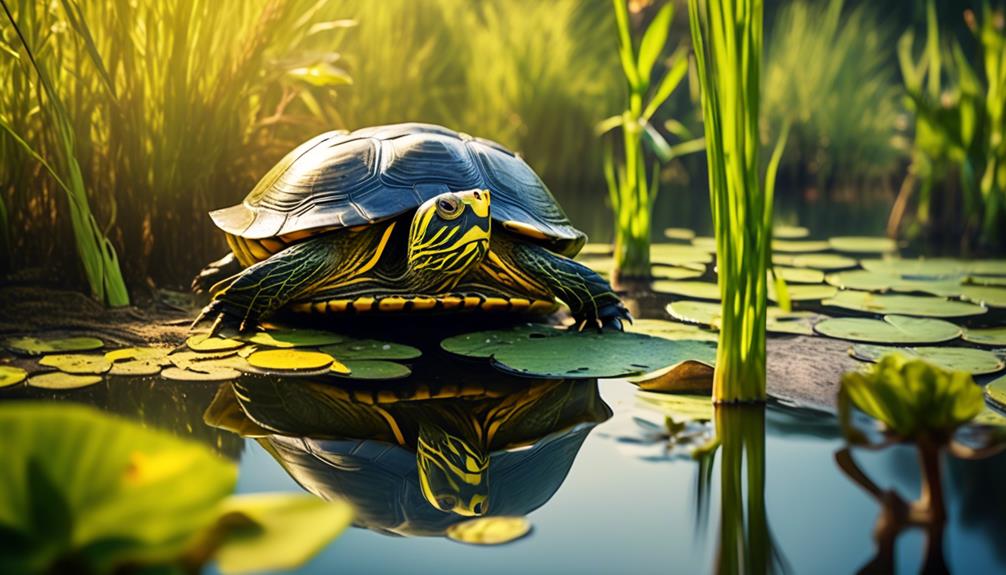
If you're interested in learning more about the Yellow-Bellied Slider's natural habitat, let's explore where these turtles can be found and the type of environment they thrive in. Yellow-Bellied Sliders are found throughout the southeastern portion of the United States, from Virginia to Alabama. They prefer shallow bodies of water with aquatic vegetation, basking areas, and soft bottoms. Their habitat includes marshes, lakes, ponds, swamps, rivers, and wetlands. Here is a table summarizing their native habitat:
| Native Habitat of Yellow-Bellied Sliders |
|---|
| Location |
| Southeastern portion of the United States, from Virginia to Alabama |
| Habitat |
| Shallow bodies of water with aquatic vegetation, basking areas, and soft bottoms |
Yellow-Bellied Sliders are well-adapted to their natural environment, allowing them to thrive in these specific conditions.
Physical Appearance
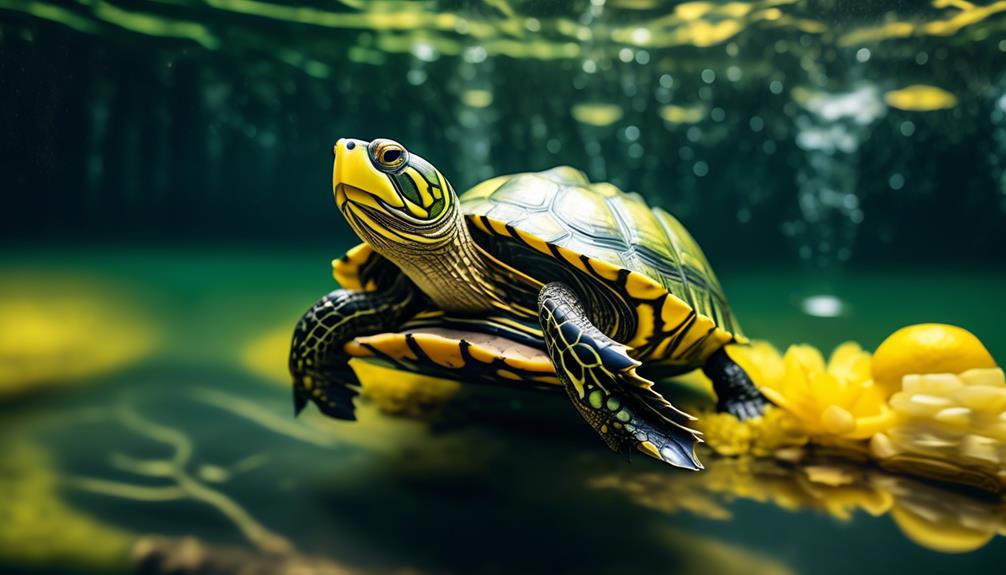
Yellow-Bellied Sliders have distinct physical characteristics that make them easily recognizable. Here are four key features that will surely captivate you:
- Vibrant yellow plastron: The underside of a Yellow-Bellied Slider's shell, known as the plastron, is a striking shade of yellow. This vibrant color stands out against their dark green or brown carapace, making them truly eye-catching.
- Olive-green carapace: The top shell of a Yellow-Bellied Slider is typically olive-green in color, with intricate patterns that add to their unique appearance. This natural camouflage helps them blend into their aquatic habitat, adding to their allure.
- Yellow striping: Along the sides of their head and neck, Yellow-Bellied Sliders boast yellow stripes that beautifully contrast with their dark skin. These distinctive markings add a touch of elegance to their overall look.
- Bright orange markings: Another feature that sets Yellow-Bellied Sliders apart is the presence of bright orange markings on their face and legs. These pops of color add a touch of vibrancy and make them even more captivating to observe.
With their vibrant colors and unique patterns, Yellow-Bellied Sliders are truly a sight to behold in the world of turtles.
Reproduction and Nesting
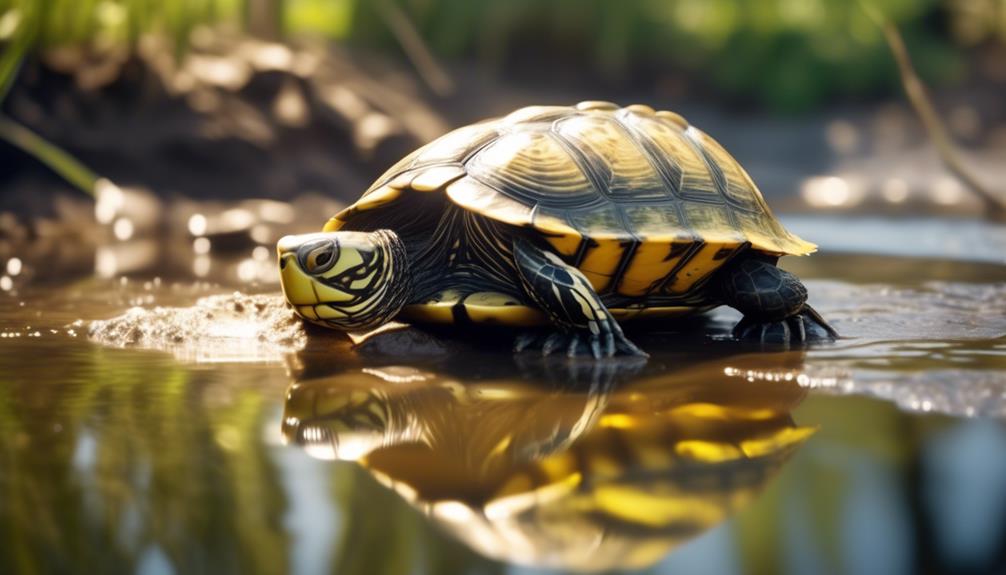
To reproduce and nest, Yellow-Bellied Sliders engage in a series of fascinating behaviors and rituals. The mating process begins with courtship displays, where males swim around females and bob their heads up and down. Once the female is ready to mate, she will position herself in the water and the male will mount her from behind. After mating, the female will search for a suitable nesting site, typically a sunny area with loose soil. She will dig a hole using her hind legs and lay a clutch of eggs, usually between 5 to 15 eggs. The eggs are then covered with soil and left to incubate for about 60 to 90 days. The sex of the hatchlings is determined by the temperature during incubation, with higher temperatures producing more males and lower temperatures producing more females. Once the eggs hatch, the tiny hatchlings will make their way to the water and begin their journey in the world.
| Reproduction and Nesting |
|---|
| – Courtship displays |
| – Mating |
| – Nesting site selection |
| – Egg laying |
| – Incubation period |
| – Sex determination |
| – Hatching and emergence |
Behavior and Temperament
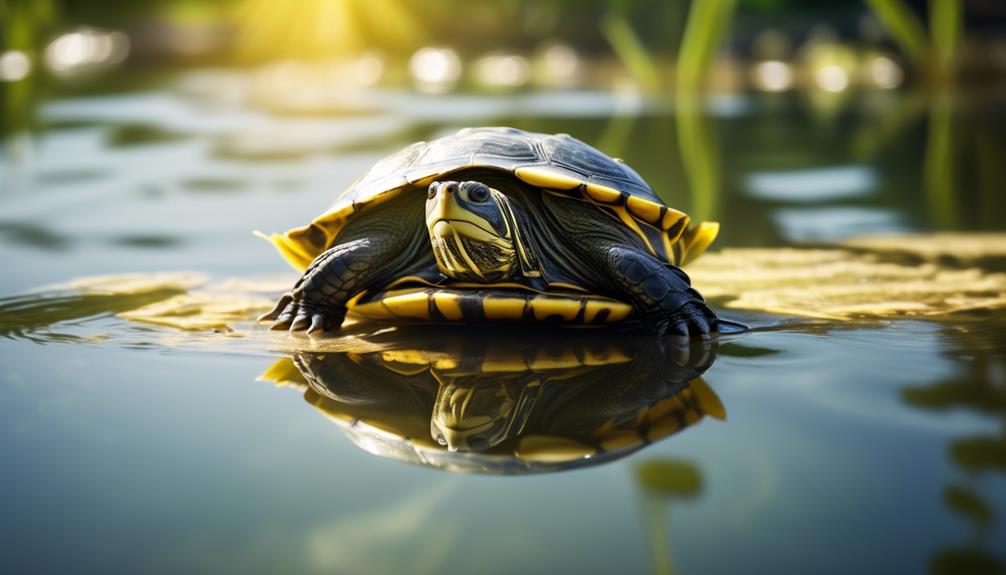
When observing the behavior and temperament of the Yellow-Bellied Slider turtle, you'll notice its unique characteristics and interactions. Here are four fascinating facts about their behavior:
- Playful and curious: Yellow-Bellied Sliders are known for their playful nature. They love exploring their surroundings and interacting with objects in their environment. Watching them swim and play can be both entertaining and heartwarming.
- Basking behavior: These turtles have a strong instinct to bask in the sun. They'll often climb onto rocks or logs to soak up the warmth. Witnessing their sunbathing sessions can be a calming experience and a reminder of the importance of self-care.
- Social creatures: Yellow-Bellied Sliders are social animals and thrive in the company of other turtles. They enjoy swimming together, basking side by side, and even engaging in gentle interactions. Seeing their social dynamics can evoke feelings of companionship and unity.
- Territorial displays: Male Yellow-Bellied Sliders can become territorial, especially during mating season. They may display aggressive behaviors, such as head bobbing and ramming, to establish dominance. Witnessing these displays can evoke a sense of awe at nature's intricate patterns of behavior.
Conservation Status
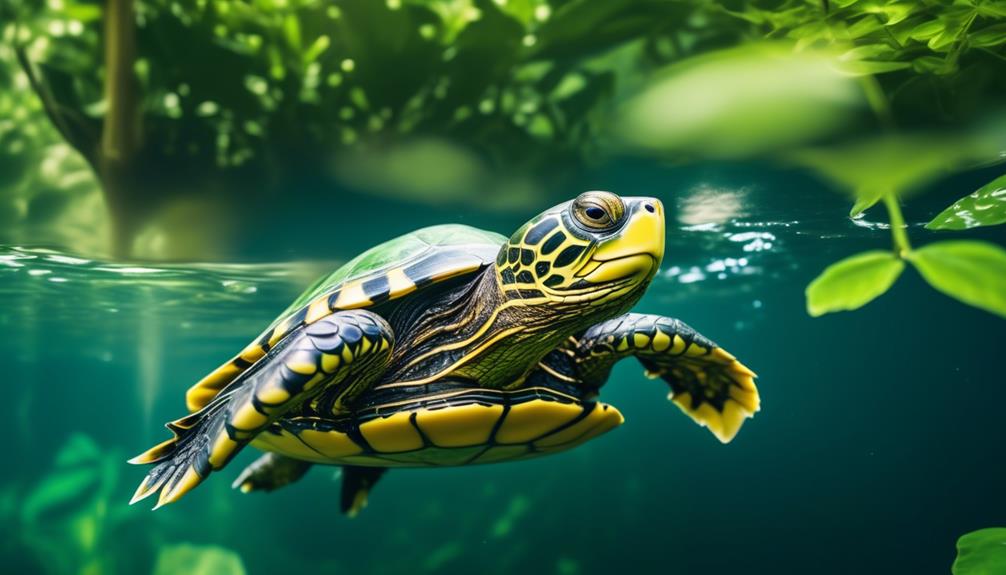
The conservation status of the Yellow-Bellied Slider turtle reflects the importance of preserving its natural habitat and ensuring the long-term survival of this species. Currently, the Yellow-Bellied Slider is listed as a species of "Least Concern" by the International Union for Conservation of Nature (IUCN). This means that the population of Yellow-Bellied Sliders is stable and not facing any immediate threats. However, it is crucial to continue monitoring their population and habitat to prevent any future decline. The main threats to their survival include habitat loss and degradation due to urbanization, pollution, and the introduction of non-native species. Efforts are being made to protect their habitats, promote responsible pet ownership, and raise awareness about the importance of conservation to ensure that the Yellow-Bellied Slider turtle continues to thrive in the wild.
| Threats to Conservation | Conservation Actions |
|---|---|
| Habitat loss and degradation | Protecting and preserving their natural habitats through land conservation efforts and restoration projects. |
| Pollution | Implementing measures to reduce pollution in their habitats, such as controlling runoff and promoting eco-friendly practices. |
| Introduction of non-native species | Monitoring and controlling the introduction of non-native species that compete with or prey upon Yellow-Bellied Sliders. |
| Irresponsible pet ownership | Educating pet owners about the proper care and responsible ownership of Yellow-Bellied Sliders to reduce the risk of releasing them into the wild. |
| Lack of awareness | Raising public awareness about the importance of conservation and the role individuals can play in protecting the species and its habitat. |
Frequently Asked Questions
What Is the Average Size of a Yellow-Bellied Slider Turtle?
The average size of a yellow-bellied slider turtle is 8 to 13 inches for females and 5 to 9 inches for males. They are medium-sized turtles with a lifespan of 20+ years.
Can Yellow-Bellied Sliders Survive Solely on a Commercial Turtle Diet?
Yes, yellow-bellied sliders can survive solely on a commercial turtle diet, but they also eat non-toxic aquatic plants, worms, fish, insects, and vegetables. It's important to provide a balanced diet for their overall health and well-being.
How Much Space Do Yellow-Bellied Sliders Need as They Grow?
As yellow-bellied sliders grow, they need a lot of space. For the first three years, a smaller tank of around 40 gallons will do, but eventually, they require at least a 75-gallon aquarium.
Are Yellow-Bellied Sliders Suitable for Families Looking for a Cuddly Pet?
No, yellow-bellied sliders are not suitable for families seeking a cuddly pet. They require moderate care, a lot of space as they grow, and do not exhibit cuddly or overly affectionate behavior.
Where Are Yellow-Bellied Sliders Commonly Found in the United States?
Yellow-Bellied Sliders are commonly found in the southeastern United States, from Virginia to Alabama. They prefer shallow bodies of water with vegetation and soft bottoms, such as marshes, lakes, ponds, and wetlands.
Can Chicken Turtles and Yellow-Bellied Slider Turtles Live Together in the Same Habitat?
Yes, colorful world chicken turtles and yellow-bellied slider turtles can coexist in the same habitat. They both require similar environmental conditions such as a warm basking area, clean water, and a varied diet. However, it is important to monitor their interactions to ensure they are not competing for resources.
Conclusion
So, now you know all about the incredible Yellow-Bellied Slider turtle. From their size and lifespan to their diet and care requirements, these turtles are truly fascinating creatures.
Whether you're considering getting one as a pet or simply interested in learning more about them, the Yellow-Bellied Slider turtle is a captivating species worth exploring.
So dive in and uncover the wonders of these amazing turtles!

